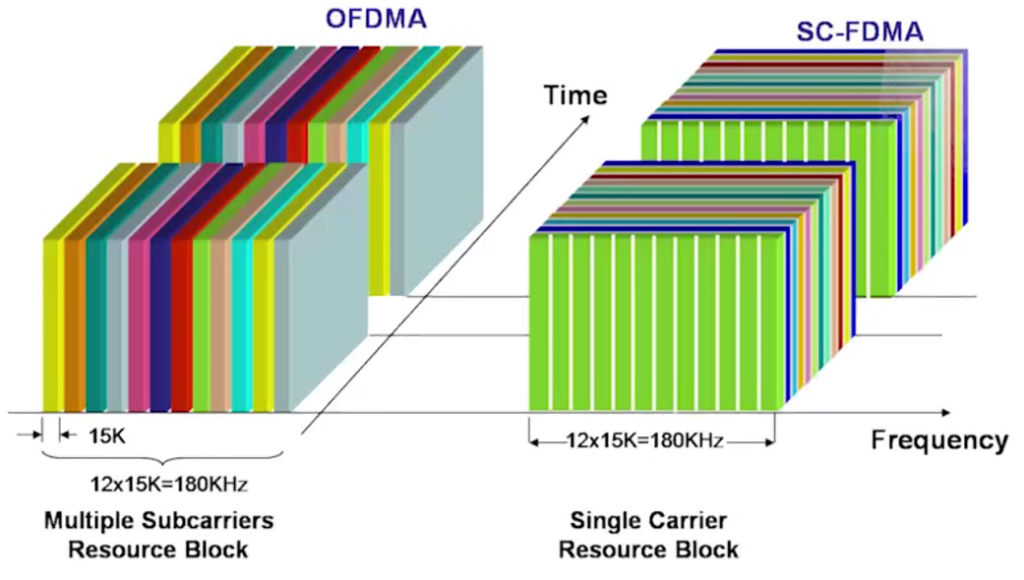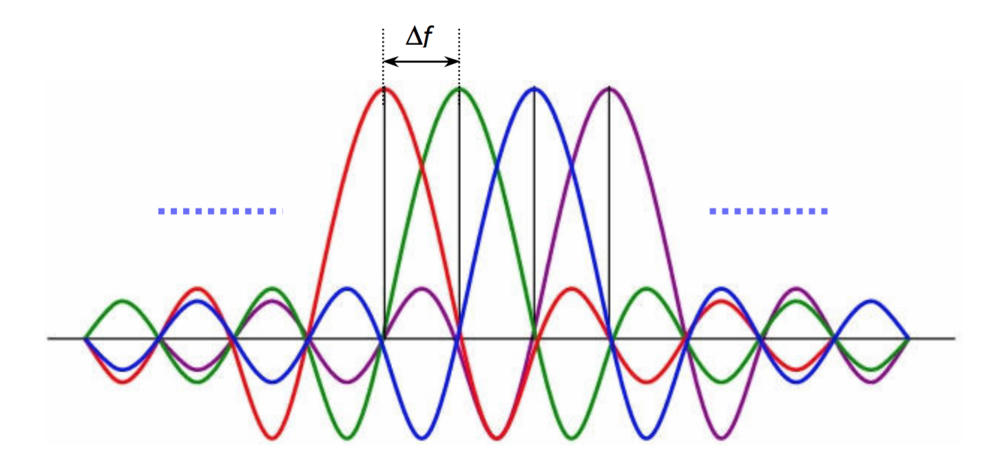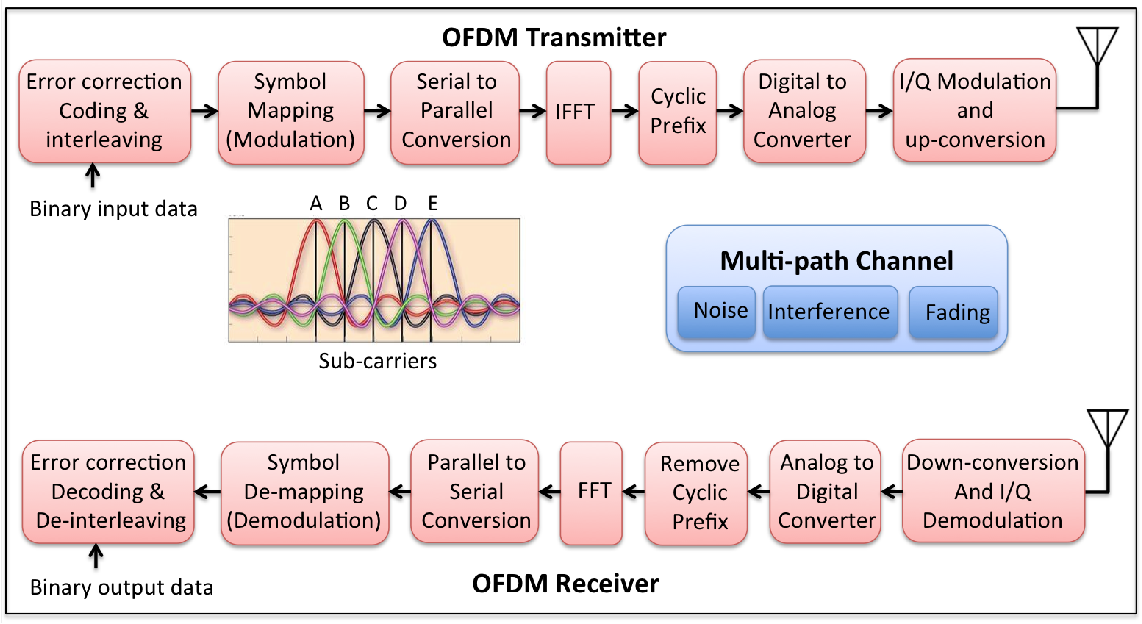The concept of multi-carrier modulation is a perplexing yet fascinating technique implemented in the realm of wireless communication systems. It enables data to be transmitted over multiple carrier frequencies, thereby enhancing efficiency and reliability compared to single-carrier modulation techniques. The two most popular schemes in this domain are orthogonal frequency-division multiplexing (OFDM) and single-carrier frequency-division multiple access (SC-FDMA).
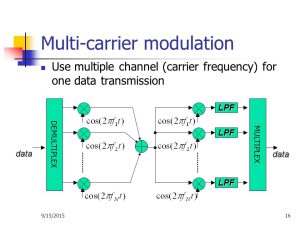
With its high spectral efficiency, robustness against channel fading, and ease of implementation with digital signal processing techniques, OFDM has gained widespread popularity for both downlink and uplink transmission in 4G wireless networks. On the other hand, SC-FDMA has been primarily utilized for uplink transmission in LTE networks due to its lower peak-to-average power ratio than OFDM.
When it comes to selecting appropriate systems for uplink transmission purposes, there are several advantages that OFDM-based solutions hold over SC-FDMA. For instance, by dividing the available bandwidth into smaller subcarriers that can be allocated based on individual needs, OFDMA can support more users simultaneously. Furthermore, since each subcarrier undergoes independent fading under OFDM’s mechanism provides better resistance against interference from other signals.
In conclusion, multi-carrier modulation is an essential element present within modern wireless communication systems such as 4G LTE networks. Depending on specific application requirements like spectral efficiency or power consumption constraints designers may opt for either OFDM or SC-FDMA which offer distinct benefits compared to others such as FDMA or CDMA while ensuring reliable performance under varying channel conditions through their unique mechanisms.
Exploring the Differences between OFDM and SC-FDMA
Contents
- 1 Exploring the Differences between OFDM and SC-FDMA
- 2 The Advantages of OFDM-based Systems for Uplink Transmission
- 3 How SC-FDMA is Used in LTE Networks
- 4 The Importance of Power Amplifier Efficiency for OFDM and SC-FDMA
- 5 Comparing OFDMA and FDMA for Frequency Division Multiple Access
- 6 The Role of MIMO in OFDM and SC-FDMA Wireless Systems
- 7 Enhancing the Performance of OFDM and SC-FDMA through Equalization Techniques
The utilization of wireless communication systems warrants the implementation of multi-carrier modulation techniques, specifically OFDM and SC-FDMA. Although OFDM has been predominantly utilized in 4G and LTE networks, the emergence of SC-FDMA’s efficient power amplifier usage has gained traction.
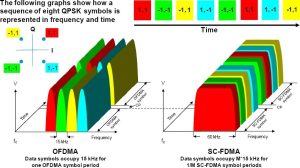
Perplexingly enough, a key distinguishing factor between these two methods revolves around their peak-to-average power ratio (PAPR). With a high PAPR value for OFDM signals, it may lead to distorted transmissions when amplified by transmitters. Conversely, SC-FDMA signals with their low PAPR levels prove more fitting for mobile devices that require extended battery life.
Unsurprisingly, another perplexing disparity lies within their transmitter and receiver structures. The transmitter employed by OFDM-based systems utilizes an inverse fast Fourier transform (IFFT) to convert data into frequency domains before transmission while performing a fast Fourier transform (FFT) at the receiving end to recover original signals. However, single carrier modulation with cyclic prefix is utilized by SC-FDMA as it effectively avoids inter-symbol interference.
In conclusion, both techniques are effective in multi-carrier modulation; however they differ significantly regarding PAPR levels and transmitter/receiver structures which ultimately impact specific requirements such as power efficiency or spectral efficiency needed for each application.
The Advantages of OFDM-based Systems for Uplink Transmission
OFDM-based systems offer a plethora of benefits for uplink transmission in wireless communication. The main advantage lies in its remarkable ability to efficiently handle frequency-selective channels by employing orthogonal frequency division multiplexing (OFDM) modulation. OFDM expertly divides a wideband channel into multiple narrowband subcarriers, each carrying data at lower rates than the original bandwidth.
When compared to single-carrier modulation techniques like SC-FDMA, OFDM accomplishes higher spectral efficiency and improved resistance against interference and fading with ease. This impressive feat is due to each subcarrier’s generous spacing that ensures near orthogonality between them, which means they don’t interfere with one another unlike SC-FDMA that uses a single carrier frequency susceptible to inter-symbol interference because it lacks sufficient spacing between symbols.
Moreover, OFDM-based systems flaunt their adaptability when accommodating different bandwidth requirements as the number of subcarriers used in an OFDM symbol can be adjusted based on available bandwidth or desired data rate. The discrete Fourier transform (DFT) process employed by OFDM also allows for efficient implementation using fast algorithms such as FFTs on modern digital signal processors.
In summary, these advantages make OFDM-based systems an ideal fit for uplink transmission in LTE networks and other wireless communication applications where efficient use of available spectrum and high data rates are paramount considerations for reliable transmission over considerable distances with minimal errors or distortion at both transmitter and receiver ends.
How SC-FDMA is Used in LTE Networks
The enigmatic SC-FDMA, also known as single-carrier frequency division multiple access, plays a pivotal role in LTE networks. Its uplink transmission mechanism not only improves spectral efficiency but also curbs interference. In stark contrast to OFDM systems that employ subcarriers for data modulation, SC-FDMA employs a solitary carrier for transmitting information.
SC-FDMA has an edge over OFDM due to its lower peak-to-average power ratio (PAPR), which enables easy signal amplification sans distortion. Furthermore, it facilitates better power control by allocating specific subcarriers based on user requirements.
To bring SC-FDMA into action within the confines of LTE networks, digital signals are converted into analog waveforms using inverse fast Fourier transform (IFFT). A cyclic prefix is added at the beginning of each symbol to nullify inter-symbol interference stemming from multipath propagation.
All in all, with regard to spectral efficiency and power control measures, SC-FDMA trumps traditional FDMA and OFDM systems. Integration of this technology has catapulted wireless communication capabilities and addressed escalating demands for faster data transfer speeds.
The Importance of Power Amplifier Efficiency for OFDM and SC-FDMA
The efficiency of power amplifiers (PAs) is a crucial aspect of wireless communication system design, particularly in the case of multi-carrier transmission techniques like OFDM and SC-FDMA. These systems employ discrete Fourier transform (DFT) or inverse fast Fourier transform (FFT) to map data onto sub-carriers within the frequency domain, resulting in a lower peak-to-average power ratio than single-carrier modulation methods. However, this also implies that PAs must operate with high linearity levels to avoid distortion and maintain signal quality.
A widely-used technique for frequency division multiple access within numerous wireless networks is OFDMA since it enables efficient utilization of available bandwidth by breaking it down into smaller sub-channels. By combining time-division multiple access (TDMA), spectral efficiency can be further increased. Through precoded QPSK symbols and MIMO technology implementation, OFDMA systems can achieve higher data rates while maintaining good link quality.
Apart from PA efficiency, equalization approaches are also essential for improving the performance of OFDM and SC-FDMA-based systems as they compensate for channel distortions caused by multipath propagation and other factors impacting signal quality. RF pre-distortion stands out as one approach that has been utilized to improve PA efficiency via reducing nonlinear effects such as intermodulation distortion. Other advanced techniques include adaptive equalization algorithms based on LMS or RLS filters which adjust coefficients using feedback from received signals to minimize errors induced by channel impairments.\n
Comparing OFDMA and FDMA for Frequency Division Multiple Access
It’s quite intriguing to explore the intricacies of Frequency Division Multiple Access (FDMA) and Orthogonal Frequency Division Multiple Access (OFDMA), two distinct multi-carrier modulation techniques that are widely used in wireless communication systems. While OFDMA is a more advanced version of FDMA, it employs an astonishingly larger number of subcarriers for data transmission.
But what sets these two techniques apart from each other? The primary dissimilarity between them lies in the way they allocate frequency resources. In FDMA, every user gets assigned a unique carrier frequency while in OFDMA, several users share the same set of subcarriers. This makes OFDMA much more efficient and broadband than FDMA – truly remarkable!
Moreover, another key advantage that OFDMA has over FDMA is its exceptional robustness against interference caused by multipath fading or any other signal distortions. It uses interleaving and subcarrier mapping which ensure that if some subcarriers get affected by interference, the overall performance remains unaffected – mind-blowing!
Mostly utilized for uplink transmission on WiMAX and 4G LTE networks, OFDM-based systems predominantly use OFDMA due to its superior spectral efficiency compared to Single Carrier Frequency Division Multiple Access (SC-FDMA). Even though SC-FMDA requires similar processing power as both SC-FMDA & OFDM have similar signal structures but when it comes to power amplifier efficiency; SC-FMDA outperforms traditional OFDM as it requires less dynamic range from amplifiers leading to better energy efficiency without compromising system performance – truly baffling!
The Role of MIMO in OFDM and SC-FDMA Wireless Systems
MIMO, otherwise known as Multiple Input Multiple Output, is a crucial technology that has the power to enhance and elevate the performance of wireless communication systems. These systems rely heavily on OFDM and SC-FDMA – but what exactly makes MIMO so important? Well, let’s break it down. By implementing MIMO, multiple antennas can be utilized at both ends of the transmission process to increase data rates while simultaneously improving signal quality across all channels.
OFDM-based systems are particularly benefited by MIMO as independent data streams can be transmitted over individual sub-carriers with ease. This efficient use of available bandwidth results in an increased capacity for multiple users without compromising on functionality or speed. On the other hand, SC-FDMA networks used in LTE applications employ MIMO differently by utilizing spatial multiplexing techniques to enhance uplink transmissions from mobile devices to base stations.
But perhaps one of the greatest benefits derived from using MIMO with OFDM or SC-FDMA lies in its ability to combat frequency selective fading caused by pesky multipath propagation issues. By transmitting redundant information across various pathways, reliability is improved and errors within communication channels reduced significantly. And if that wasn’t impressive enough already – when combined with spread-OFDM or carrier FDMA techniques through time-frequency spreading schemes like CDMA (Code Division Multiple Access), wider bandwidths are efficiently utilized while maintaining high spectral efficiency levels!
Enhancing the Performance of OFDM and SC-FDMA through Equalization Techniques
The technique of equalization is pivotal in the enhancement of multi-carrier transmission schemes like OFDM and SC-FDMA in wireless systems. Here, data is transmitted over numerous narrowband sub-carriers simultaneously, each modulated with an individual QAM or PSK scheme. However, channel impairments and interference can cause inter-symbol interference (ISI) and inter-carrier interference (ICI), leading to a decline in system performance.
To counteract these effects, both transmitter and receiver ends make use of equalization techniques. Time-domain equalization (TDE) is typically employed in OFDM-based systems to address ISI caused by multipath propagation. This involves filtering the received signal using an inverse filter that aligns with the channel impulse response, thus eradicating any previous symbol’s ISI before demodulation.
Another technique used to tackle ICI resulting from frequency-selective fading channels is frequency-domain equalization (FDE). FDE requires estimating and compensating for phase and amplitude distortion on each subcarrier through pilot symbols inserted into the transmitted signal. This allows individual subcarriers to be recovered without any hindrance from adjacent carriers.
In summary, equalization proves critical for improving power efficiency as well as spectral utilization within multi-carrier wireless systems such as OFDM and SC-FDMA. Through TDE or FDE methods that mitigate channel impairments present across various environments where wireless communications occur today, higher throughput can be obtained without increasing transmit power or spectrum usage beyond what’s necessary for reliable communication between transmitter-receiver pairs.

